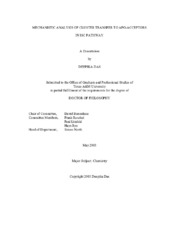| dc.description.abstract | Iron-sulfur (Fe-S) clusters are ubiquitous protein cofactors that are required for some of the most important reactions in nature, including nitrogen fixation, oxidative phosphorylation, and photosynthesis. Multiple biosynthetic pathways have evolved for assembling Fe-S clusters and delivering them to protein targets. The ISC (Iron-Sulfur Cluster assembly) pathway is found in many prokaryotes and in eukaryotic mitochondria. A central component of the pathway is a cysteine desulfurase, which uses a pyridoxal phosphate (PLP) cofactor to convert cysteine to alanine and functions as a sulfur source. The scaffold protein IscU combines this sulfur with ferrous iron and electrons to synthesize Fe-S clusters. The Fe-S clusters can then be transferred to acceptor proteins such as the monothiol glutaredoxins (Grx4 in bacteria, GRX5 in humans) and ferredoxin (Fdx). The chaperone co-chaperone pair (HscA-HscB) accelerate cluster transfer reactions from holo-IscU to Grx4 and Fdx. In eukaryotes, Fe-S cluster biosynthesis is stimulated by frataxin (FXN), which is associated with the neurodegenerative disease Friedreich’s ataxia (FRDA). To gain a mechanistic understanding into these processes, we employed stopped-flow kinetic analysis and developed visible circular dichroism, fluorescence reporter, and radioactivity-based assays. Importantly, we develop the first complete functional assay in which Fe-S clusters are built and then transferred to a target protein. Here, studies will be presented that show (1) FXN accelerates specific steps in the PLP-associated chemistry of the cysteine desulfurase, interprotein sulfur transfer, and intermediate Fe-S cluster formation on the scaffold protein; (2) a FXN suppressor mutant identified on the scaffold protein functions differently than FXN, accelerating cluster transfer from the scaffold protein to GRX5; (3) glutaredoxin functions as an intermediate carrier in cluster transfer reactions from IscU to apo acceptor proteins Fdx and HcaC; and (4) chaperones accelerate cluster transfer reactions from IscU to Grx4 and do not appear to assist in the folding or unfolding of the target proteins. Overall, this work provides new mechanistic insight into specific steps of Fe-S cluster assembly and transfer and may provide new opportunities for drug discovery to treat FRDA. | en |


